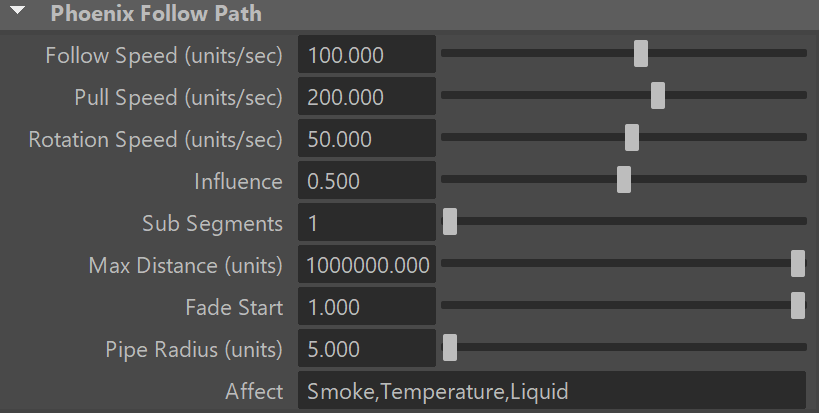Page History
This page provides information on the Follow Path (PhoenixFDFollowPath) component.
Overview
...
| Section | |||||||||||||||||||||||||
|---|---|---|---|---|---|---|---|---|---|---|---|---|---|---|---|---|---|---|---|---|---|---|---|---|---|
|
Follow Path Curve
...
...
Spline | spline – Specifies the selection set for the spline object providing the path.
...
Remove Object – Removes selected objects from the follow path curve calculation.
Parameters
...
Follow Speed (units/sec) | axspunits – Specifies the terminal velocity of the fluid moving along the spline. This part of the force is most pronounced inside the pipe.
...
Liquid - affects the Liquid particles in a Liquid simulation.
Splashes - affects the Splash particles in a Liquid simulation.
Foam - affects the Foam particles in a Liquid simulation.
Mist - affects the Mist particles in a Liquid simulation.
Air - affects the space in a Liquid simulation where there are no Liquid particles, when Simulate Air Effects is enabled in the LiquidDynamics rollout. All particles such as Foam, Splash or Mist outside the liquid volume will be influenced.
Temperature - affects the voxels in a Fire/Smoke simulation where the Temperature is different than the default 300 Kelvins. The higher the temperature above 300 or the lower it is below 300, the stronger the effect of the force would be. You can find out more about Phoenix Grid Channel Ranges here.
Smoke - affects the voxels in a Fire/Smoke simulation where there is Smoke. The denser the smoke, the stronger the effect of the force would be.
Fuel - affects the voxels in a Fire/Smoke simulation where there is Fuel. The denser the fuel, the stronger the effect of the force would be.
...



